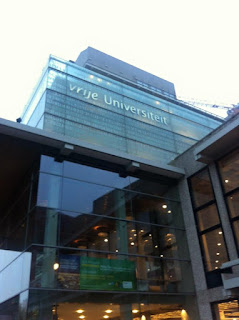The first HEI visited has a literal translation of the Dutch name Vrije Universiteit of "Free University". "Free" refers to independence of both state and church. Both within and outside the University, the institution is commonly referred to as "the VU" (pronounced somewhat like "vew" as in "new"). In English, therefore, the university uses the name "VU University". Though founded in 1880 as a private institution, VU has received government funding on a parity basis with public universities since 1970. Abraham Kuyper, Prime Minister of the Netherlands from 1901 to 1905, founded VU University Amsterdam. At first the university was only open to Reformed Christians and was entirely financed by their fund-raising efforts and donations. Since the 1960s, however, VU University Amsterdam has been open to everyone and funded in the same way as the other Dutch universities, although it still retains its tradition of Christian standards and values.
We had a most enjoyable moring there in a building that was reminisent of the Barbican building, followed by lunch and the usual transport problems with tram stations that will not sell tourists tickets...
The afternonn was spent in the University of Amsterdam (UvA) has a rich history dating back to 1632, when its forerunner, the Golden Age school Athenaeum Illustre, was established. In 1815, the Athenaeum Illustre was recognised by law as an institution of higher education and, in 1876, granted the right to confer doctoral degrees and given its current name, the University of Amsterdam. The UvA operated under the executive authority of the City of Amsterdam until 1961, at which time it became an independent public entity. Today, with some 30,000 students, 5,000 staff, more than 100 nationalities and a budget of more than 600 million euros, it is one of the largest comprehensive universities in Europe.
We enjoyed again some great and detailed presentations and discsssions on the themes. The universities so far have prepared very well indeed!
There were some very well designed buildings on their outer campus that we had the pleasure of being shown round. The library was commendably busy even at 6pm!
The three interesting findings from today's visits were:
- There is a binary system in the Netherlands with academic universities and professional Hogschule (in English 'Universities of Applied Technology')
- There seems to be a large number of Germans in Dutch HE (the largest sources of non-Dutch students being the US, German, China and the UK).
- There is a structured series of personal research grants from the Dutch research council, called vini, vidi, vici. Classicists may draw a wry smile at that...


No comments:
Post a Comment